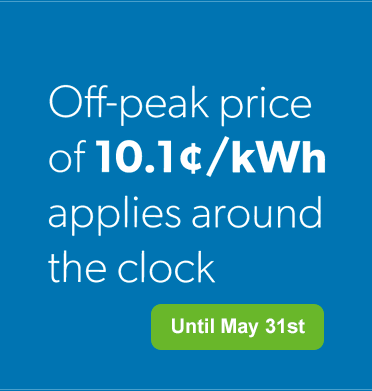The Ontario government just extended fixed time-of-use (TOU) prices at the off-peak rate. Beginning June 1st, Ontario residents will revert back to winter TOU rates.
Normally, we would have moved to summer electricity pricing on May 1st with the on-peak period switching from morning to afternoon. Staying on the winter schedule provides customers with lower mid-peak rates in the afternoon when energy usage tends to be higher due to summer air conditioning. For two-tier clients, winter pricing provides an additional 400 kWh at the lower 1st tier rate.
We applaud the Ontario Government for taking immediate steps in March to decrease Ontarian’s electricity bills, however, at some point in the near future, we are going to have to address that we do not pay the true cost of power. The return to regular TOU pricing will highlight the cost increases that came into effect last November; the on-peak rate is now 20.8 cents. In summer 2019, it was 13.4 cents. To decrease the shock value of the rate increases and to try to keep bills relatively constant, the government increased the value of the Ontario Energy Rebate (OEB) to 20-30% of the bill depending on service classification and other factors. Take a look at your most recent bill to see this. Here in the Blackline Power office, we consumed 878 kWh in February for a total bill amount of $145.91. Our OEB was $57.14. Without this, the bill would have been ~$200. We regularly see bills from our commercial clients who are receiving rebates of up to $2,000/month. How can this be sustainable?
The news that the costs of keeping electricity rates in Ontario artificially low have ballooned to $5.6 billion a year has further reinforced the need for a serious reconsideration of the province’s approach to energy matters.
– Mark Winfield, the conversation.com, February 2020
Solar will buffer you from increasing electricity costs for decades. When you have a net metering solar system, your current electricity meter is replaced with a bi-directional one and you use the energy you produce, receive credits for any extra power (for up to 12 months) and purchase power if needed. Delivery charges are comprised of both a monthly standard fee to be connected to the grid and a variable fee that changes according to the amount of power you purchase. The benefit of net metering is that the credits are based on both the electricity rate and the amount of variable delivery charges that are offset. So, if you purchase no power from Hydro One in a month, you only pay the standard service fee. It’s also important to note that because the current bi-directional meters cannot register time-of-use rates, net metering clients are switched to two-tier pricing. Thus, if you use less than 1,000 kWh/month, your electricity rate is only 11.9 cents, no matter what time of the day you consume it. Note: As the electrical grid is constrained in some areas (and thus net metering is not available), we also install grid-connected zero export systems. Contact Blackline to learn more.

